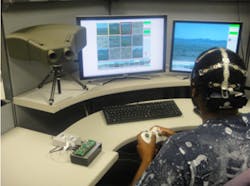Brain power boosts recognition rate of image analysis system
Researchers at DARPA have demonstrated the effectiveness of a system that couples cameras, computers and input from an operator's brainwaves to detect threats to soldiers in the field.
DARPA launched the Cognitive Technology Threat Warning System (CT2WS) program in 2008 with the goal of maximizing soldiers' awareness of their surroundings. Now, they have shown that the CT2WS system is capable of identifying up to 91 percent of targets during testing.
The CT2WS system includes three components: a 120-megapixel, tripod-mounted, electro-optical video camera with a 120-degree field of view, cognitive visual processing algorithms that can be run on computers to identify potential targets and cue images for operator review, and an electroencephalogram (EEG) cap that monitors the operator's brain signals and records when the operator detects a threat.
CT2WS built on the concept that human beings are inherently adept at detecting the unusual. Even though a person may not be consciously aware of movement or of unexpected appearance, the brain detects it and triggers the P-300 brainwave, a brain signal that is thought to be involved in stimulus evaluation or categorization.
A human user who is wearing an EEG cap can then rapidly view the filtered image set and let the brain's natural threat-detection ability indicate to the computer which images were significant.
The cognitive algorithms running on the computer highlight many events that would otherwise be considered irrelevant but are actually indications of threats or targets, such as a bird flying by or a branch’s swaying, while the use of EEG-based human filtering significantly reduces the amount of false alarms.
In testing of the full CT2WS system, the sensor and cognitive algorithms returned 810 false alarms per hour. When a human wearing the EEG cap was introduced, the number of false alarms dropped to only five per hour, out of a total of 2,304 target events per hour, and a 91 percent successful target recognition rate. By incorporating a commercial radar system into the mix (the Cerberus Scout surveillance system), target detection reached 100 percent.
Field tests of the CT2WS system were conducted in desert terrain at Yuma Proving Ground in Arizona, in tropical terrain in Hawaii, and in open terrain at California's Camp Roberts. DARPA provided a final demonstration of the CT2WS system to Army officials at Fort Belvoir, Virginia.
The companies involved in developing the system were HRL Laboratories (Malibu, CA, USA), Advanced Brain Monitoring (Carlsbad, CA, USA), Quantum Applied Science & Research (San Diego, CA, USA) and the University of California San Diego (San Diego, CA, USA).
Other recent developments involving DARPA that you might also be interested in.
1. Vision system gets stitched up
Engineers at Softwear Automation (Atlanta, GA, USA) have been awarded a contract worth $1.25 million from the Defense Advanced Research Projects Agency (DARPA; Arlington, VA, USA) to develop a vision-based work cell capable of automatically sewing garments.
2. Gigapixel camera employs multiple image sensors
Duke University researchers have developed a 1-Gpixel camera capable of imaging scenes with a 120° field of view.
3. Smarter software helps military surveillance
DARPA has engaged 12 research teams to develop software suitable for employment on a camera for use on an unmanned ground vehicle which will make use of both computer vision and artificial intelligence techniques.
-- Dave Wilson, Senior Editor, Vision Systems Design
